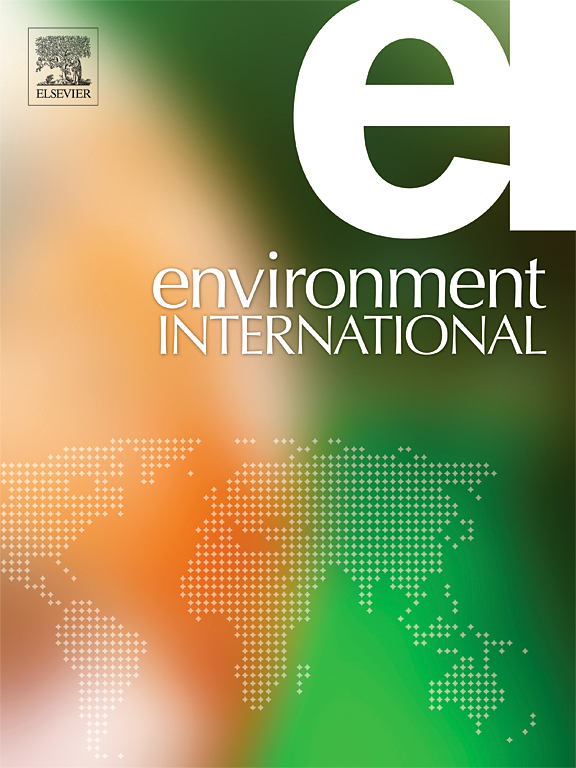商业鼠标垫中添加剂和化学过敏原的发生、皮肤和无意摄入暴露以及人类健康风险
IF 9.7
1区 环境科学与生态学
Q1 ENVIRONMENTAL SCIENCES
引用次数: 0
摘要
在日常生活中,鼠标垫与人体皮肤的长时间摩擦接触反复发生,但市面上的鼠标垫中添加剂和化学过敏原的发生情况及其潜在危害尚不清楚。为了解决这一知识差距,本研究评估了中国70种商业鼠标垫中的五类添加剂。靶金属(loid)s的浓度最高(42 ~ 120000 μg−1),其次是硫化促进剂(0.1 ~ 2100μg−1)、苯并噻唑类(0.1 ~ 1400μg−1)、增塑剂(1 ~ 310000 μg−1)和苯二胺(0.1 ~ 100 μg−1)。皮肤致敏物(0.1-2100 μg−1)和受调节的亚硝基物质(0.3-22 μg−1)也被鉴定出来,特别是在一般使用的鼠标垫、电子竞技鼠标垫和橡胶鼠标垫中。红外加热鼠标垫(1800 ~ 310000 μg−1)比普通鼠标垫(73 ~ 160000 μg−1)和电子竞技鼠标垫(150 ~ 120000 μg−1)含有更多的目标化学物质。通过皮肤接触和无意的手到口摄入的目标化学物质的估计每日暴露剂量是相当的。通过加热鼠标/桌面垫和皮革鼠标垫无意地用手到嘴摄入具有显著的非致癌风险,但其他鼠标垫的风险微不足道。然而,考虑到鼠标垫中广泛存在各种添加剂,特别是那些引起皮肤致敏的添加剂,在鼠标垫中采用绿色和低/非皮肤致敏剂是非常可取的。本文章由计算机程序翻译,如有差异,请以英文原文为准。
Occurrence, dermal and unintentional ingestion exposure, and human health risk of additives and chemical allergens in commercial mouse pads
Prolonged frictional contact between mouse pads and human skin occurs repeatedly in daily life, but occurrence and potential hazards of additives and chemical allergens in commercial mouse pads remain poorly understood. To address this knowledge gap, the present study evaluated five classes of additives in 70 commercial mouse pads from China. Target metal(loid)s exhibited the highest concentrations (42–120000 μg g−1), followed by vulcanizing accelerators (0.1–2100 μg g−1), benzothiazoles (0.1–1400 μg g−1), plasticizers (1–310000 μg g−1), and phenylenediamines (0.1–100 μg g−1). Skin sensitizers (0.1–2100 μg g−1) and regulated nitrosatable substances (0.3–22 μg g−1) were also identified, particularly in the mouse pads for general usage, e-sports, and rubber-type. Mouse pads with infrared heating (1800–310000 μg g−1) contained more abundant target chemicals than those for general usage (73–160000 μg g−1) and e-sports (150–120000 μg g−1). Estimated daily exposure doses of the target chemicals via dermal contact and inadvertent hand-to-mouth ingestion were comparable. Unintentional hand-to-mouth ingestion with heated mouse/desk pads and leather mouse pads poses significant non-carcinogenic risk, but insignificant risk with other mouse pads. However, given the widespread occurrence of a variety of additives in mouse pads, particularly those that cause skin sensitization concerns, adoption of green and low/non-skin sensitizers in mouse pads is highly desirable.
求助全文
通过发布文献求助,成功后即可免费获取论文全文。
去求助
来源期刊

Environment International
环境科学-环境科学
CiteScore
21.90
自引率
3.40%
发文量
734
审稿时长
2.8 months
期刊介绍:
Environmental Health publishes manuscripts focusing on critical aspects of environmental and occupational medicine, including studies in toxicology and epidemiology, to illuminate the human health implications of exposure to environmental hazards. The journal adopts an open-access model and practices open peer review.
It caters to scientists and practitioners across all environmental science domains, directly or indirectly impacting human health and well-being. With a commitment to enhancing the prevention of environmentally-related health risks, Environmental Health serves as a public health journal for the community and scientists engaged in matters of public health significance concerning the environment.
 求助内容:
求助内容: 应助结果提醒方式:
应助结果提醒方式:


